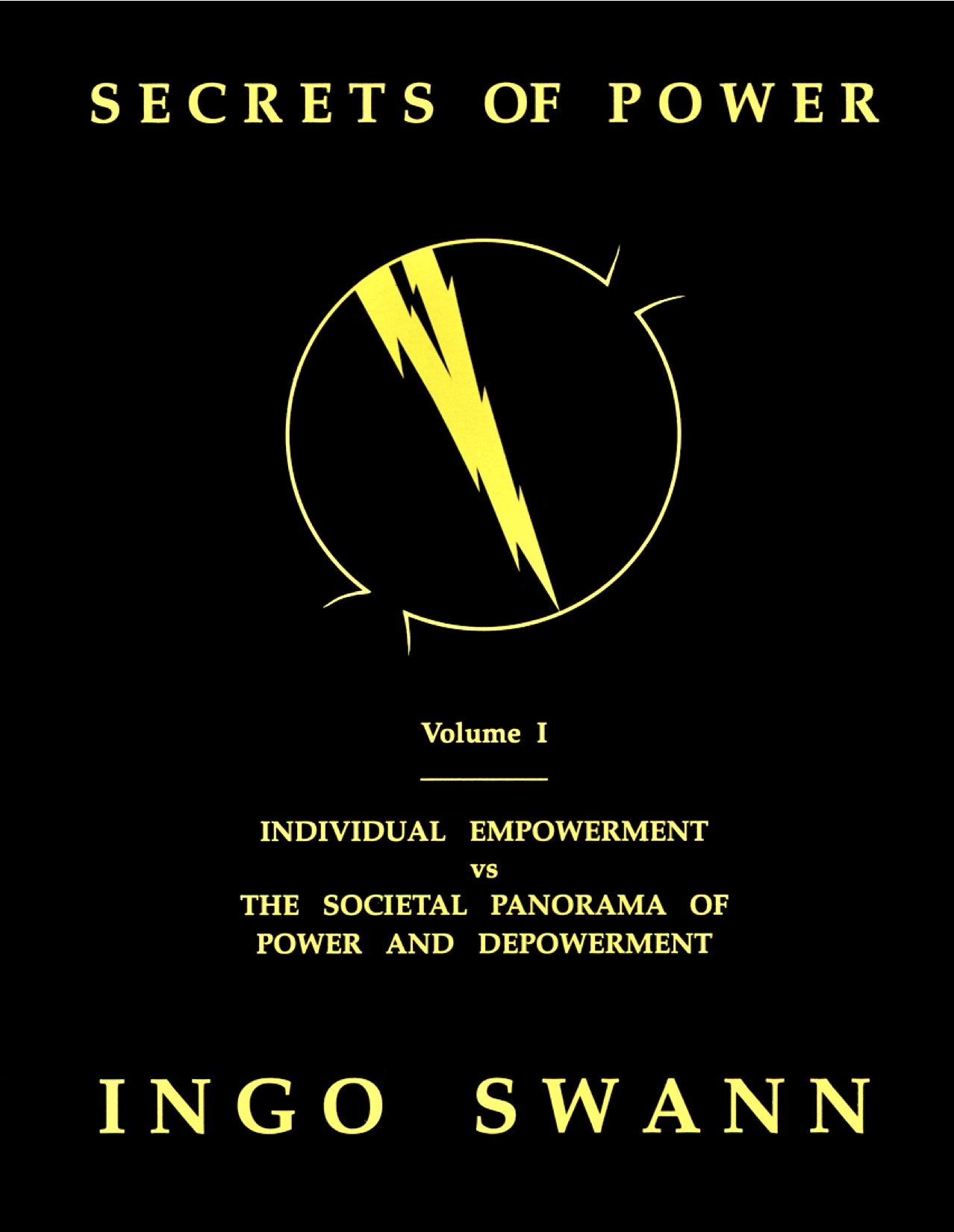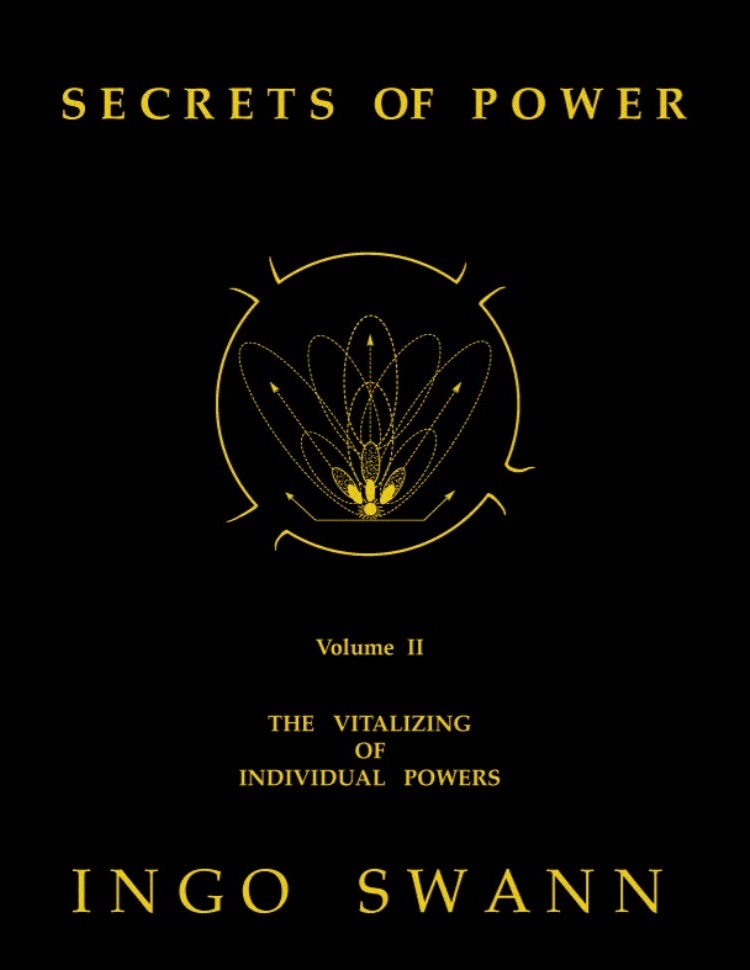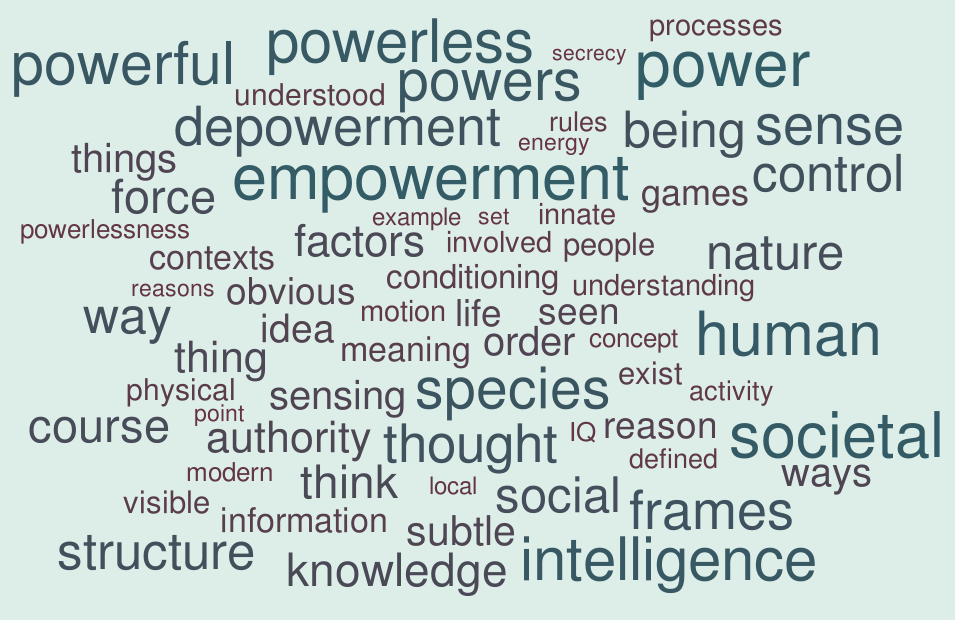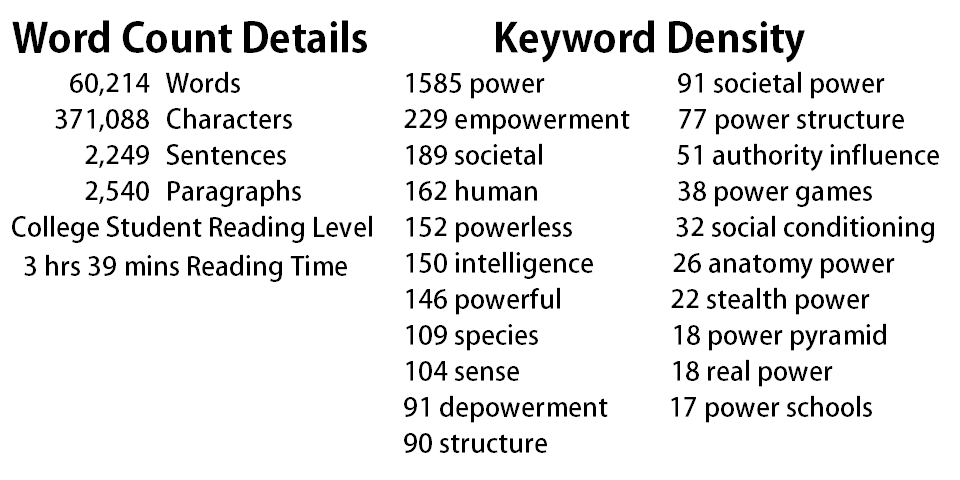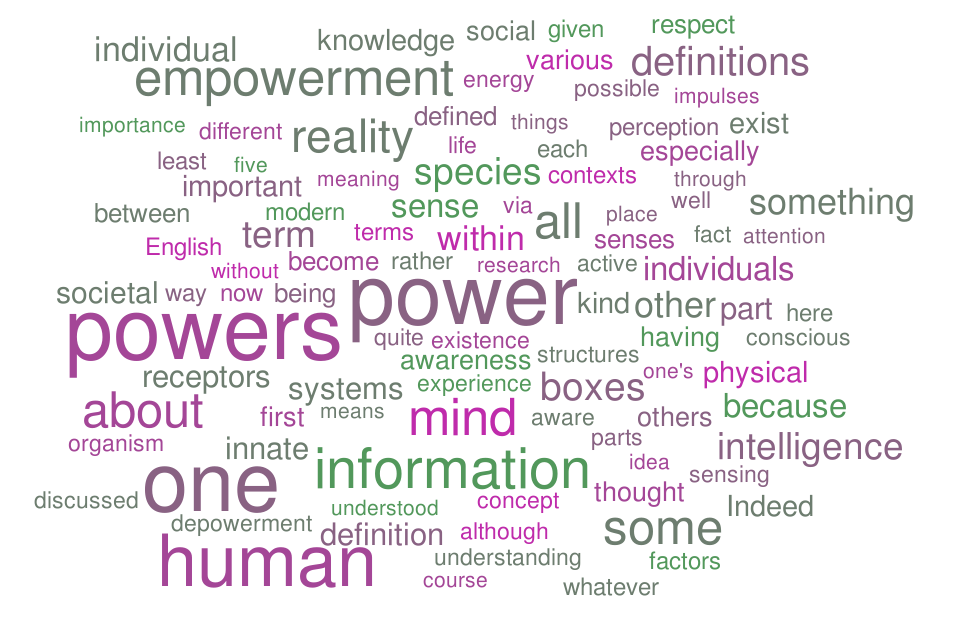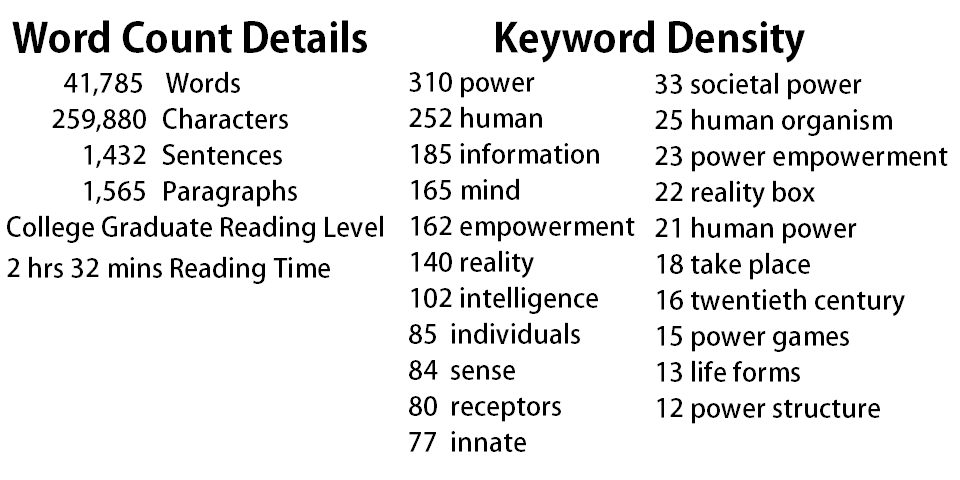| Secrets of Power by Ingo Swann | [Source] |
|
|
Most books about power only deal with the societal formula of the few having power over the enormously larger powerless masses, and which is mistaken as the so-called “natural order of power.”
But it is not well understood that this formula also requires social conditioning measures aimed at perpetuating the continuing depowerment of the powerless so that the powerful CAN have power over them.
This in turn requires the societal suppression and secretizing of all knowledge about the superlative human powers known to exist in individuals of the human species, but which are socially forced into latency in most.
It is broadly understood that power and secrecy go together, but the scope of the “web” of secrets surrounding the larger nature of human power(s) is surprising. As discussed in this Volume I of SECRETS OF POWER, empowerment is difficult if the larger panorama of societal power and depowerment are not more full understood.
Any desire for more individual empowerment will soon encounter the question of WHAT to empower. There are many ways to consider this. One way is first to identify human power elements that are known to exist, but DO NOT receive societal nurturing, enhancement, training, scientific research, or philosophical interest.
In-depth research will reveal at least five major categories of these power elements, one such category consisting of the aware powers innate in everyone of our species. The direct relationship between the spectrum of aware powers and increases of power is self-evident. The direct relationship between less or no awareness and less or no power is also self-evident.
Most societal power structures do not encourage too much development of any aware and related powers, and, via societal programming of punishment, some structures force them into latency altogether. One basic reason is that too much awareness erodes the efficiency of walls of secrecy that support the elite of most power structures, whether large or small.
Most are familiar with the awareness they have. But few are familiar with the awarenesses they don't have, but which anyway innately exist within their otherwise amazing information systems.
|
The best plan is to profit by the folly of other. The shortest and best way to make your fortune is The trouble with the world is that the stupid are Everybody is a little bit of a toady in the face of the It is the business of the future to be dangerous … Nothing is illegal if 100 business men decided to do it, The rules are … there are no rules. (Aristotle Onasis) Why level downward to our dullest perceptions |
THE MORE things change, the more they remain the same' is an old adage that applies to many human activities.
But it certainly applies to the activities of human societal power. Its outer circumstances and formats change over time, but its inner workings remain remarkably the same.
One of the inner factors that remains the same consists of the ever on-going distinctions between the powerful and the powerless that prevail through time and circumstances.
- Thus, one may talk of ancient or modern civilizations and empires, and even of the forthcoming "globalization process," and still be talking of the powerful versus the powerless.
Two other factors also remain the same: (1) the general lack of interest in the nature of the powerless, i.e., why the powerless ARE powerless; and (2) the enormous fascination with the powerful, and with possibilities of becoming powerful.
- This fascination is extremely prevalent, and is shared by the powerless and the powerful, the latter of which are fascinated with themselves and have little interest in the powerless.
- Indeed, there is more fascination with the dramatics of power and achieving powerfulness than with the principal mandate of our species -- survival into the future, the prospect of which by now has become something of an unpredictable gamble.
There is another significant factor that needs to be taken into account, although it might at first seem quite distant from the problems of power.
- This has to do with the enormous amount of discovered data, information, and knowledge that is avoided, forbidden, made taboo, swept under carpets, or simply trashed.
Brain researchers often say that we use only ten to fifteen percent of our brains. It's also quite possible to think that we use only ten to fifteen percent of discovered knowledge.
- One may ask what these two somewhat unexplainable discrepancies have to do with power. Well, its entirely possible that we know only ten to fifteen percent about the nature of power, and that we utilize only ten to fifteen percent of our innate powers.
- Why a species equipped to function at higher percentages of everything should remain confined to ten percept performance is an awesome situation to meditate on.
Most information sources regarding power seem to end up giving two basic impressions about it:
- That it is more or less straightforward and easy to understand -- IF one has the intelligent wherewithal to do so; and
- That what is seen as power in both the individual and societal realms reflects some kind of natural order -- and which automatically establishes the legitimacy of the differences between the powerless, the relatively powerful, and the powerful.
It would be a great mental and emotional relief if the two impressions did reflect the basic nature of power. But they do not – and cannot if the word "human" is prefixed to the term "power.''
The two impressions are possible only if power is seen as one-dimensional – i.e., seen either from the bottom up, so to speak, and/or from the top down.
- But, as is well known, anyone who manages to think outside of the one-dimensional aspects of power soon becomes aware that power has very many dimensions. And, indeed, in many pre-modern cultures, it was often said that power has a thousand faces.
Whether discussed as being multi-dimensional or as having multiple faces, the inescapable meaning is that power, in its intrinsic nature, is complex.
- This in turn means that any real examination of power will be fraught with problems having to do with uncertainty.
- And indeed, if ever there was a realm of human activity totally encumbered by uncertainties, the realm of power activity clearly tops the list.
Societal power is considered a very precious commodity, perhaps the most precious. Access to it is therefore a matter of ultra-intense competition. In turn, easy access to the competition itself must be guarded in order to limit the numbers of possible competitors.
There is only one really efficient way to guard against access to power, and that is to conceal, prohibit, and secretize all real knowledge about it.
- It is unbelievable to think that real knowledge about the nature and workings of power is unavailable. But the ultra-precious commodity has been with us throughout history.
- Thus, various long-term ways and means have been engineered to keep the majority dumbed-down about the nature of power so that it can be more efficiently sequestered in the hands of the few.
The long-term result is that most do not comprehend very much about power. But most do appreciate two well-known facts about it:
- That power is what individuals can bump up against as they proceed through their lives; and
- That power is also what, literally speaking, can thump across individuals attempting to proceed through their lives.
There is a basic fact that those aspiring to empowerment must face, sooner or later: societal power is almost always more powerful than the individual, even more powerful than groups of them.
- Thus, in seeking empowerment, individuals WILL bump up against a variety of real-life societal situations already structured to control and delimit too much empowerment by too many.
- Unless the aspirant understands something of what will be bumped up against along those societal lines, it is probable that not much will happen except a grinding of gears. Therefore the first mandate for achieving empowerment is to become cognizant of those societal factors and forces already geared to preventing it on a very large scale.
In view of this unavoidable mandate, this first volume of SECRETS OF POWER is confined to twenty-eight chapters.
- Each discusses some SOCIETAL aspect of power and depowerment, and all of which, in real-life feed-back, can defeat and even trash individual attempts at empowerment.
- At the end of each chapter are some suggested items to observe in real life Out There, or some suggested exercises that might help increase awareness along those lines.
- One seldom gets anywhere unless there is some kind of map to follow.
|
Experience is not what happens to a man, it is Many are stubborn in pursuit of the path they The more intelligent a man is, the more originality As a rule, I always look for what others ignore. Talent is like electricity. We don't understand Consciousness of our Powers Augments Them. There are plenty of people to whom the crucial |
POWER UNFOLDMENT at the individual level is probably one of the most spectacular of all human phenomena.
We can say this at least hypothetically – because we know that individuals innately have more powers than those few permitted by various societal formats and the empowerment power restrictions in them.
It is because of such restrictors that we do not often witness spectacular individual power unfoldement per se.
What we usually see instead is just enough unfoldment of individual personas so as to fit them, one way or another, into various slots within their social and societal environments.
And as discussed throughout Volume I of this series, those social and societal environments in fact determine what power is to be or not to be. And it is thus power that tends to be understood only within the contexts of social power games, while innate human powers are seldom understood if at all.
If the foregoing is considered as calmly as possible, it can then be seen that the human is a social creature as well as an individual, and that where the one leaves off and the other begins is quite difficult to determine. And so there are difficulties establishing what The Individual actually is.
The concept of The Individual is, of course, quite precious and meaningful, and especially so within the philosophical systems of the highly developed countries of the modern West.
- But it is fair to point up that the concept of an individualistic persona, and the philosophy of individualism as such, did not really achieve formal description until the nineteenth century. Up until then, the term INDIVIDUAL generally applied only to separate things within a given group or category.
***
In the early 1830s, the French politician and writer, Alexis de Tocqueville (1805-1859) undertook a government mission to the United States to study penal systems. But he studied American politics and behavior, too.
- These studies resulted in his famous book DEMOCRACY IN AMERICA (1835), in which, among other things, he indicated that "Individualism is a novel (American] expression to which a novel idea has given birth. Individualism is a mature and calm feeling, which disposes each member of the community to sever himself from the mass of his fellow creatures and to draw apart with his family and friends."
This "novel idea" caught on like a wild fire, and was soon given more terse definition as: "Self-centered feeling or conduct as a principle; a mode of life in which the individual pursues his own ends or follows his own ideas; free and independent individual action or thought; egoism."
By 1870, INDIVIDUALISM had even achieved, of all things, a metaphysical definition: "The doctrine that the individual is a self-determined whole, and that any larger whole is merely an aggregate of individuals, which, if they act on each other at all, do so externally."
By 1884, the term had been given an additional definition as "The social theory which advocates the free and independent action of the individual as opposed to communistic methods of organization and state interference."
Meanwhile, earlier in about 1840, the term INDIVIDUALIST had come into general usage and was defined as: "One who pursues an independent or egoistic course in thought or action."
- Needless to say, individualists are easier to recognize than are the many nuances of individualism that usually have diverse complications and gray areas surrounding them.
|
Everybody wants to be somebody: nobody wants The tragedy of life is not so much what men suffer, Those who do not feel pain seldom think that it is felt. Man is a sun; and the senses are his planets. One's real life is often the life that one does not lead. Where is your Self to be found? Always in the deepest |
These definitions, all formulated during the nineteenth century, have been provided here for what they are worth in general.
- They continue to seem sensible enough at first take. But the concepts they initially established have proven to be quite superficial, and so there has been little agreement among subsequent authorities as to what the individual consists of.
One of the on-going problems that seems to be involved is quite similar to one that plagues concepts of empowerment at the individual level. Certain concepts can be functional within a given level of reality, but not in others.
- Another way of stating this is that certain concepts can be real enough in various mind-sets or given reality boxes, but have lesser or no meaning in others.
It is this multiplicity of levels of reality, mind-sets, and reality boxes that complicates the contexts of empowerment, and those of power itself – for, as many come to realize, or perhaps experience to their surprise – empowerment and power can be achieved within certain contexts, but can fall flat in others.
This is to emphasize that given ideas of The Individual, of empowerment, and about power emanate from the mind-sets or reality boxes that produce them. And, as most can realize, what works for a given reality box can be ineffective, meaningless, and sterile with respect to others.
***
There is one possible reason it has proven so difficult to establish conclusive definitions about what The Individual consists of
- This is that the Individual is the reality box in which The Individual is dwelling at any given time, and out of which is produced The Individual's thoughts and actions – and also, it may as well be said, The Individual's operative survival ratio into the future.
If all reality boxes were the same in clone-like accord, and always remained that way through the generations, then what individuals consist of could be defined with some precision – and, as well, their thoughts and actions could efficiently be predicted.
Indeed, elements of this kind of thing can easily be identified in the reality-box conditioning practices of most societal power structures. In those structures, the less powerful and the powerless are supposed to exist in clone-like accord as determined by the power structure, whether it is large or small.
From this kind of thing, it can be concluded, in a larger-picture way, that societal power structures can initiate and maintain reality-box cloning. Well, yes.
But there is an even larger picture. For, as is understood, and as our history demonstrates, the reality boxes of this and that societal power structure come and go – to be REPLACED by new and other ones requiring new and other reality-box cloning practices.
If this is contemplated upon as serenely as possible, there is only ONE WAY that such multiple reality-box transitions can occur.
While it IS the case that societal power structures can initiate this or that reality-box cloning and management, it is the HUMAN SPECIES that has the generic and innate power to manufacture reality boxes of ANY kind.
- After all, wheresoever humans are or go, there also will be found reality boxes of this or that kind, and nowhere can be found a human that is entirely reality-boxless.
***
In that this is so, it is the better part of valor to assume that whatever the species has downloads into each and all specimens of it. It is thus that we find all individuals have reality boxes, whether of the tattered or highly organized kind.
Because of the magnitude involved, the innate species power of manufacturing reality boxes is a wondrous thing – the direct implication being that there are no real or even illusory realities that permanently fall outside of possible or potential cognizance.
It can be understood, however, that possible or potential cognizance on such a scale is something that is problematical to most power structures – whose stability much depends upon not too much cognizance outside of whatever cognizance is permissible.
***
One of the bottom lines of this small discussion is that there are two general perspectives regarding individual empowerment.
- One can seek empowerment within the contexts of some kind of social or societal reality-box power games. This perspective is, of course, entirely recognizable. One can seek empowerment within the contexts of human powers that are innate and contained in our species. This perspective is not very recognizable, because what human powers actually consist of falls into the category of forbidden knowledge.
With respect to this latter perspective (and as discussed throughout Volume I), the best way to preserve the pyramidal power structure format and the power status of the few, is to prevent information and knowledge about power, human powers, and empowerment from accumulating and becoming accessible to all individuals who might benefit from it.
It is thus, even in our present age of information gluts, that there are no socially endorsed power schools or encyclopedias that reveal in-depth information about power and all that can be associated with it.
These absences are particularly noticeable within the modern age of so-called universal enlightenment, and which, to be sure, has produced encyclopedic knowledge sources for just about everything else.
The traditional concept most central to the longenduring pyramidal power structure arrangement holds that the majority of individuals are born innately inferior to those who are born innately superior to them, especially with respect to intelligence.
The many sad and revolting implications of this longenduring concept have been discussed in Volume I of this series – and, as well, in a recent book entitled THE MAKING OF INTELLIGENCE, by Ken Richardson (Weidenfeld & Nicolson, London, 1999), herewith highly recommended to anyone seriously interested in individual empowerment.
Any enlightened discussion of the revolting traditional concept brings into view a very important, two-part question regarding individual empowerment:
whether most, or even some, individuals are naturally born without innate powers; or
whether, via the processes of social conditioning, individuals are rendered ignorant of their innate powers, an ignorance that works to diminish those innate powers into inactive states.
At least part of an answer here is that it is difficult to see how individuals can function at all unless they are born with an innate spectrum of powers, a spectrum that, furthermore, is quite extensive as will be considered in the text ahead.
Just because a large number of those powers can be rendered non-operational by social conditioning should not be taken as proof-positive that a spectrum of innate powers does not exist in each individual.
***
This author posits and accepts that all individuals born of our species ARE born with a rather large spectrum of innate powers – especially that of mind-intelligence and which requires the support of several subsidiary kinds of powers.
But it is also posited that few realize what the fuller spectrum of their powers are because there is no place one can consult in order to find out what they are. And the continuing absence of detailed encyclopedias about human powers will ensure the perpetuation of this particular kind of non-knowledge.
While there are no encyclopedias that specialize in describing human power phenomena, it can be discovered that many earlier dictionaries identify and define numerous powers. The two dictionaries this author majorly depends on are Webster's Seventh New Collegiate Dictionary (1974), and the much more extensive Oxford Dictionary of the English Language. Other sources consulted are identified in the text.
It is difficult to surmise what individuals think power consists of. But the evidence is very good that many identify power and empowerment within this or that social context – the home, the local environment, various peer groupings, the work place, various economic workings, the career industries, the ever-changing political and professional competitions, and etc.
It is of course important to learn how to better survive and function within social contexts, and so there is nothing intrinsically amiss with such aims.
But there are important distinctions to be made between social context empowerment and the contexts of innate human powers in general. And in fact, it can be discerned or intuited that recognition and enhancement of one's own innate powers can magnify one's empowerment in social contexts.
Beyond the individual, group, social, and cultural levels is the much bigger picture of the human species itself.
If the species level is considered, it can certainly be understood that all power and empowerment activities, no matter where, when, or to what degree, are manifestations within the overall species context.
In that context, whatever individuals are or become, they are first and foremost members, or life units, which are downloaded from within the proliferating species out of which they have descended.
The contents of this volume are thus based in the observable fact that the human species possesses a large range of powers, and that these, in formative essence, download into each individual born of the species.
At least some of these powers are so innately basic that no individual can achieve any kind of operational or functional survival without them – and it is a discussion of some of these basic powers, innately present in all individuals, which provide the principal contents of this volume.
***
A WORKING DEFINITION OF HUMAN POWERS IS BEST ESTABLISHED AS INNATE, INBORN SOURCES OF SUPPLYING ENERGY – AND WHICH SOURCES ARE CAPABLE OF MAGNIFICATION, OF DECREASE, OF BEING LATENT AND UNTAPPED, AND OF BEING DE-ENERGIZED OR DEPOWERED
Indeed, synonyms for POWER are usually given as force, energy, strength, and might. These synonyms reflect qualities of power that can be exerted physically and mentally – all of which can be nurtured and enhanced, or caused to be latent or weakened.
As with the issues discussed in Volume I, the topics selected for presentation in this volume can be identified and verified by those individuals interested in doing so.
|
INTRODUCTION
|
PART THREE: THE SITUATION OF POWER PERSONAL
|
|
PART ONE: STRATEGIC BACKGROUND VISTAS REGARDING EMPOWERMENT
|
PART FOUR: GETTING BEYOND SOCIETAL, GROUP, AND INDIVIDUAL VERSIONS OF POWER
|
|
PART TWO: THE SOCIETAL PANORAMA OF POWER
|
PART FIVE: SUBTLE CONTEXTS RELATING TO EMPOWERMENT
|
|
INTRODUCTION
PART ONE: NOVEL OVERVIEWS RELEVANT TO EMPOWERMENT
PART TWO: TUNIDENTIFIED PARTS OF MIND
|
PART FOUR: INDIVIDUALS HAVE RECOGNIZABLE INNATE BASE POWER SYSTEMS
PART FIVE: THE REAL EXISTENCE OF HUMAN GROKING POWERS
|
Ingo Swann (1933-2013)
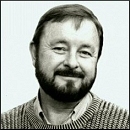 Photo by Dr. Elmar Gruber |
Few of us get to be the originators of anything unique, much less something so revolutionary that it just might change the entire world. Yet that is the case with Ingo Douglas Swann, who passed away from the effects of a stroke on the 31st of January, 2013 at the age of 79. Ingo was born in Telluride, Colorado on September 14, 1933, and was both sensitive and intuitive almost from his first awareness. He experienced an out-of-body state at 2 years of age in which, though fully anesthetized during a tonsillectomy, he was able to observe and later report accurate details of the procedure. That event initiated an ongoing series of out-of-body and clairvoyant experiences that he quickly learned not to share with any but his maternal grandmother, who herself had a sensitivity for such things.
Ingo took his education at Westminster College in Salt Lake City, Utah, earning a double degree in art and biology. He served a three-year enlistment in the US Army, much of it in Korea in an administrative position with the 8th Army. During this time he became bridge partner and friends with Madame Syngman Rhee, the Austrian-born wife of South Korea's first president, and played an important behind-the-scenes role in preventing a major international incident, for which he received a letter of commendation.
Out of the Army and transplanted to New York City in the early 1960s to begin his art career, Ingo supported himself for 12 years as an employee in the Secretariat of the United Nations in various roles. While nurturing his fledgling art career, he made the acquaintance of many of the literati and intellectuals in New York social circles of the day, including people such as artist Andy Warhol, whose parties Ingo attended just a few blocks from his own residence in the Bowery.
Some of these connections led him to the world of experimental parapsychology which was enjoying a heyday in the Manhattan of the mid-to-late 1960s and early 1970s. Gertrude Schmeidler of the City College of New York, with whom Ingo worked on psychokinesis research, and Karlis Osis, of the American Society for Psychical Research, with whom he became involved in out-of-body perceptual work were two of the more prominently active parapsychologists at the time. In 1971 Ingo proposed a new parapsychology research protocol that involved participants in trying to "observe" locations or settings separated from them by either distance or shielding under fully-blind conditions. He named this protocol "remote viewing," and it served as the kernel around which all of the discipline of remote viewing and its various aspects ultimately formed.
Cleve Backster, a leading pioneer in polygraph and "lie-detector" development was also engaged in the forward edge of consciousness research, and Ingo became affiliated with this researcher as well. The connection with Backster soon led to a defining moment in Ingo's career. After coming across a communication sent to Backster by Dr. Harold E. "Hal" Puthoff proposing an experiment based on Backster's "Primary Perception" theories, Ingo volunteered himself to participate in the research.
Puthoff invited Ingo to the Stanford Research Institute (SRI) in Menlo Park, California. On June 6, 1972 the two of them performed a watershed experiment in the basement of the Varian Physics Building on the Stanford University campus. With no previous access to a large-scale magnetometer being used for fundamental physics research, Ingo was able to both mentally influence the output of the heavily-shielded device and to correctly clairvoyantly sketch the relationships of elements in the internal mechanism.
Word of this success eventually reached the Central Intelligence Agency's Office of Technical Services, and Puthoff was shortly visited by representatives of the CIA, who further tested Ingo's abilities and offered a preliminary $50,000 contract to explore both the psychokinesis (PK) and the new-found remote viewing phenomena. This was the beginning of a 23-year involvement of the US Government in remote viewing research and applications. In 1976 Ingo directly involved his good offices in recruiting nuclear physicist Ed May who would one day come to head the SRI effort.
Though other remote viewers were recruited and, where necessary, taught or trained, Ingo remained a central figure in the program, suggesting new research directions and participating in thousands of remote viewing trials, both research-oriented and for practical applications. Starting in the late 1970s and continuing through the first half of the following decade, Hal Puthoff and Ingo focused on isolating and identifying the underlying principles and, eventually, developing a system to convey to naive subjects the techniques and competencies of successful, well-experienced remote viewers.
This research ultimately culminated in what is known today as "controlled remote viewing" (CRV - originally called "coordinate remote viewing"). The process progresses through six "stages," beginning from general mental contact with the target and subsequently guiding the viewer's consciousness up through increasingly detailed target access. CRV proved successful in developing remote viewing capabilities in naive subjects, and in 1982 was first offered to the Army to further develop the military remote viewing program already underway.
Due to changes in Army politics, the SRI training contract was completed at the end of 1984, and never renewed. The military program officially moved on from the Army to the Defense Intelligence Agency at the end of January, 1986. The CRV methodology was used extensively and successfully during the following years of the program. Ingo continued to be associated and participate with SRI until 1989, when he declared his retirement from parapsychology research.
There followed two decades of fruitful writing and painting, where Ingo authored several popular books, articles, and content for his own comprehensive website, biomindsuperpowers.com. Ingo was a popular, sought-after speaker who, nonetheless limited his speaking engagements. The International Remote Viewing Association was fortunate to have him speak at three of its conferences, plus an additional one it co-sponsored with the Association for Research and Enlightenment in Virginia Beach, Virginia.
After his retirement, Ingo occasionally dipped his toe back briefly into active parapsychology research. He worked chiefly with Dr. Michael Persinger at Laurentian University in a set of fruitful experiments attempting to identify correlations between remote viewing functioning and brain activation.
But mortality beckoned. Ingo overcame a bout with mouth cancer, and then in December 2003, he suffered a serious fall on the icy New York City streets, shattering his femur. Hospitalized for over two weeks, he was nursed through a long and difficult recovery process by his sister Murleen and his friend Bob Durant. But from that point on his health remained somewhat fragile, though he still engaged in discussions and occasional lectures, as well as appearances at several of the conferences of the International Remote Viewing Association, of which he was always the honored guest.
Appropriately, at the time of his passing Ingo was well along in organizing and producing a book of his marvelous artwork, a final legacy to bestow on the world. We have hopes that this book will eventually be made available for us all to appreciate and enjoy.
Now, just a few days after his passing, Ingo Swann is already sorely missed. Our planet is, indeed, emptier without him in it. But what he left behind will contribute to the developing of higher levels of human consciousness for many years to come - indeed, likely forever.
Paul H. Smith
February 5, 2013
Since 1970, Ingo Swann has worked with over 38 cutting-edge researchers in the fields of parapsychology and cognitive perception, with an additional 14 projects governed by nondisclosure agreements.
His early 1970-1972 work with parapsychology researchers based in New York produced results that attracted international attention and acclaim. By 1973, with thousands of experimental trials counted up, he was broadly noted as parapsychology’s most tested “guinea-pig.”
However, he is best known for his long-term association with Dr. H. E. Puthoff at Stanford Research Institute (SRI). This work (between 1972 and 1988 in the field of remote viewing) achieved high luminosity because of sponsorship by U.S. intelligence and military Through these years, hundreds of thousands of experimental trials contributed to increases of knowledge that had not been attained elsewhere.
After his retirement in 1989 from such big-time research, Swann continued intermittent work with advanced researchers in the fields of multidimensional mental imagery, perception, and refined brainwave studies.
Swann’s 32-years of work is unified by four principal factors
- His original and continuing focus was not on parapsychology models alone, but included the larger fields of extraordinary awareness and perception faculties. He understands these faculties to be naturally existing and always available within the human and which, at the species biomind level, transcend cultural and societal boundaries.
- He has always been an advocate of a much-needed multidisciplinary approach to problems of human awareness thresholds and the delicate mental expertise that can be discovered about them.
- He has basically viewed the phenomena of clairvoyance, telepathy, psychokinesis and remote viewing from the overall and bigger humankind level, rather than from the smaller personal, individual, or soci-specializing levels.
- since faculties for expanded awareness and perception exist as a full part of the human biomind at the species level, he has always considered it necessary to research, discover, and remedy social and cultural factors that prevent their nurturing and development.
All of these factors were incorporated into the fifteen year research project at Stanford Research Institute, and helped produce development of various important but hitherto unknown aspects of remote viewing. The project also researched and leaned heavily on hundreds of published papers and information drawn from scientific sources outside the boundaries of parapsychology focus.
In a socio-cultural sense, Swann’s overall 30-odd years of work roughly covers two periods of mainstream intolerance-tolerance ratios. Always and only working with accredited scientists, his work between 1970-1985 took place within a long established milleu of extreme scientific and mainstream intolerance to human faculties of expanded and refined perception.
Since 1985, this intolerance has ameliorated considerably, largely due to advancing discoveries about the impressive extent of biological receptors of the human body-mind, many of which account for extraordinary human sensing faculties.
Continuing discovery confirming the remarkable nature of the human genome has also clearly established that the genetic basis for those faculties is present in most individuals, although remaining socially non-nurtured and undeveloped. As of 2000, however, extreme intolerance against scientific development of telepathy remains abundantly active.
In summing up his three decades of work and research, Swann holds that human sensing-perceptive systems are, in their total and probable scope, extraordinary and remarkable, and that they are composed not only of known factors, but also of potentials not yet identified and studied. But human sensing-perceptive systems are complex, especially when expanded and developed into higher-stage functioning.
In the face of these glorious systems, simplistic, insular, and dogmatic approaches are seldom Useful either with regard to understanding them or specially with regard to developing them.
Therefore, increasing amounts of inter-disciplinary information need to be drawn from any source possible and organized into the larger picture of all that is involved.
A partial archive of many factors involved can be found in his website http://www.biolmindsuperpowers.com
A PARTIAL LISTING OF RESEARCH AND EXPERIMENTS IN WHICH INGO SWANN HAS PARTICIPATED:
- 1971: Began active participation in parapsychological laboratory work.
- 1971: Research with Clive Backster, New York (plant consciousness and psychokinetic effects of small samples of graphite).
- 1971: Research with Dr. Gertrude Schmeidler, City College of New York (psychokinetic effects upon continuously recorded temperature) .
- 1971-1972: Research with Dr. Karlis Osis, The American Society for psychical Research, New York (out-of-body consciousness and perceptions).
- 1972: Research with Dr. C. Silfen, The American Society for Psychical Research, New York (temporal and spatial perception of remote viewing potentials).
- 1972: Research with Dr. H. E. Puthoff, Stanford Research Institute (psychokinetic perturbation of a superconductor-shielded Josephson effect magnetometer).
- 1973: Research with Dr. H. E. Puthoff, R. Targ and H. Sherman, Stanford Research Institute (experimental psychic probe of the planet Jupiter in attempting to identify distance measurement of consciousness).
- 1973: Research with Dr. W. Harman, Stanford Research Institute (experimental prophetic correlations, an experimental efforct at world-wide predictive trend analysis correlated with adept/inept dimension alternative future histories).
- 1974 – 1988: With Dr. H. E. Puthoff, Stanford Research Institute, continuous in depth reaearch funded by government clients (CIA, DIA, DOD, Army Intelligence). The operative nature and directions of this long-term research activity were classified in 1975 by the participating sponsors, and remain classified of the year 2001.
- 1974: Research with A. Twitchell, Dr. J. Mitchell, Dr. J. Wingate, and Dr. G. Schmeidler, Society for Psychical Research (precognition, an attempt to ascertain consciousness variables in. predictive ability)
- 1974: Research with Dr. G. Schmeidler, Dr. S. Krippner, and Dr. ,J. Mitchell, New York (an experimental remote viewing probe of a distant planet Mercury).
- 1975: Research with Dr. R. Miller, Atlanta, Georgia (psychokinetic effects in a diffusion cloud chamber).
- 1975: Research with Dr M. Vogel, San Jose, California (psychokinetic effects on electrical reactions of a plant).
- 1975: Research with Dr. E. May and C. Honorton, Maimonide Medical Center, New York (a dynamic PK experiment with Ingo Swann).
- 1975: Research with Dr. J. Vallee, Dr. A. Hastings, and Dr. G. Askevold, Institute for the Future, Palo Alto, California (cross-country remote viewing experiments utilizing computer conferencing).
- 1976: Research with Dr. w. Roll and G. Solfin, Psychical Research Foundation, Durham, M.C. (long-distance remote hearing experiments).
- 1976: Research with Dr. S. Krippner, and J. Mitchell, and H, Sherman (cross-country remote viewing of the planet Mars).
- 1977: Research with Dr. C. Tart, University of California at Davies (direct clairvoyant viewing of internal state of an ESP learning machine).
- 1974-1979: A special interest in utilizing audio-visual methods for presenting psychical and consciousness phenomena, including artistic: expressioning. Produced five slide shows in association with J. Turchuk:
- Cosmic Art.
- The remote viewing probes of H. Sherman and I. Swann of the planets Jupiter and Mercury.
- The beauties of Kirlian and laser light photography demonstrating mental interference patterns.
- Parapsychology in art.
- Death – a Concept Reborn; clinical death and recovery experiences.
- 1989: Retired from active government research and from public appearances.
- 1989: Research with Dr. Elmer Greem in the Voluntary Controls Program at The Menninger Foundation, Topeka, Kansas; Physical Fields and States of Consciousness: Consciousness, Body Electricity, and Psycho-physical Learning, and Anomalous Electrostatic Phenomena in Exceptional Subjects.
- 1990 onward: Began occasional research with Dr. Gerald Epstein involving volitional control of mental image management, accessing subconscious imagery, decoding information on content of biomind imagery, and entering into trans dimensional imagery.
- 1998: Research with the Laurentian University Neuroscience Research Group, Dr. M.A. Persinger, Professor of Neuroscience and Psychology, and Dr W. Roll. This research consisted of a full MRI of head and brain; complete neuro-psychological, cognitive, and personality assessments; near-infrared and Glial Matrix functions associated with remote viewing; electroencephalographic correlates; study of possible mechanisms for long distance mental imaging; neuro physiological process enhancement by experimentally generated complex magnetic fields. Novel equipment (the “Octopus”) detecting brainwave activity above high beta.
- Year 2000: Second research sequence with Dr. M.A. Persingar and D.r W. Roll at Laurentian University ln Sudbury, Canada. The research included extensive EEG analysis of brainwave frequencies between 40-60 cycles per second during clairvoyant, telepathic, and remote viewing tests. Specific frequencies were found to be consistently active during repeated testing. Experiments with novel equipment designed to apply selected brainwave frequencies outside the skull showed that certain frequencies enhanced para-sensory perceptions by several magnitudes.
Many of the research papers and documents that involved Ingo can be downloaded and viewed [HERE].
The closest to the actual training methods Ingo created & handed over to the U.S. military can be downloaded here: 1985 CRV in house training manual & notes – Author; Tom McNear.
